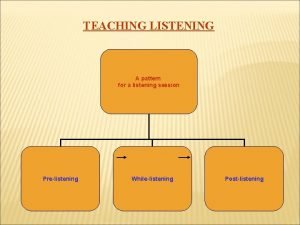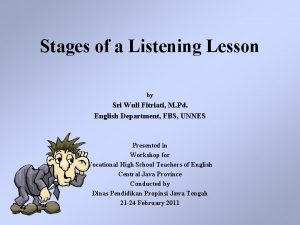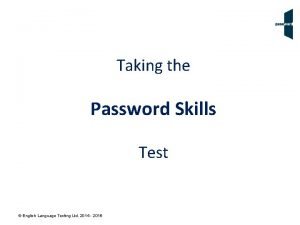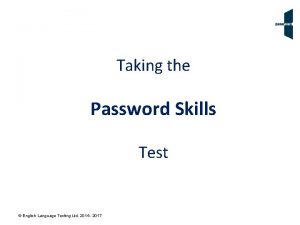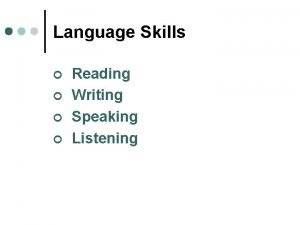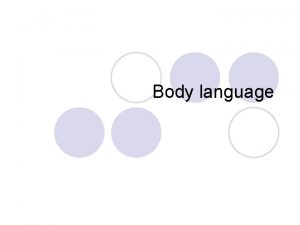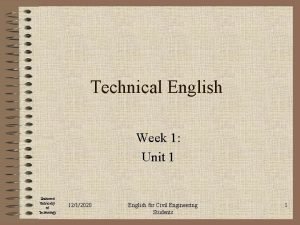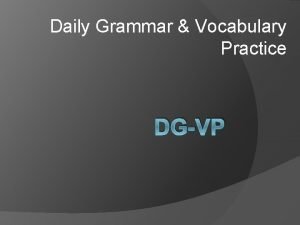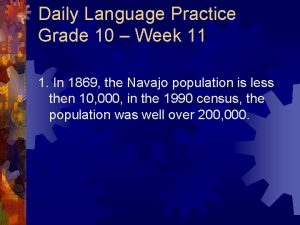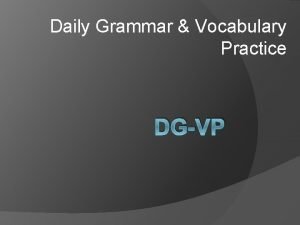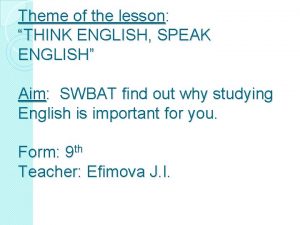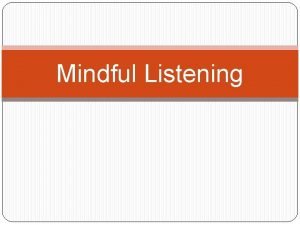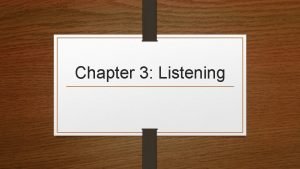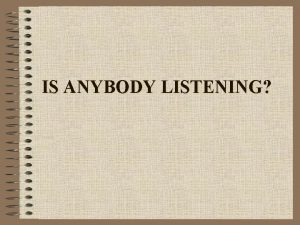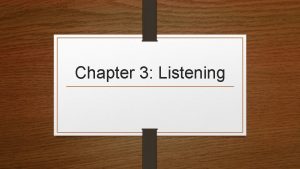English language 4 WEEK 3 WEEK 3 LISTENING























- Slides: 23

English language 4 WEEK 3

WEEK 3 Ø LISTENING COMPREHENSION TEST Ø SPEAKING EXERCISE Ø VOLLEYBALL WORKSHEET, LEARN ENGLISH, BRITISH COUNCIL (READING COMPREHENSION, SPEAKING, VOCABULARY) Ø BEACH VOLLEYBALL Ø VOLLEYBALL PPT: o DESCRIPTION AND BRIEF HISTORY Ø SHORT VIDEO TOP 25 BEST VOLLEYBALL ACTIONS Ø PASSIVE VOICE PRACTICE

VOLLEYBALL Ø Volleyball is a sport played by two teams on a playing court divided by a net. There are different versions available for specific circumstances in order to offer the versatility of the game to everyone. Ø The object of the game is to send the ball over the net in order to ground it on the opponent’s court, and to prevent the same effort by the opponent. The team has three hits for returning the ball (in addition to the block contact). Ø The ball is put in play with a service: hit by the server over the net to the opponents. The rally continues until the ball is grounded on the playing court, goes “out” or a team fails to return it properly.

VOLLEYBALL Ø In Volleyball, the team winning a rally scores a point (Rally Point System). When the receiving team wins a rally, it gains a point and the right to serve, and its players rotate one position clockwise. Ø Volleyball is one of the most successful and popular competitive and recreational sports in the world. It is fast, it is exciting and the action is explosive. Ø Volleyball comprises several crucial overlapping elements whose complimentary interactions render it unique amongst rally games.

DISTINCTIVE ELEMENTS OF THE GAME Ø William Morgan, the game’s creator, states that Volleyball has retained certain distinctive and essential elements over the years. Some of these it shares with other net/ball/ racquet games: o Service o Rotation (taking turns to serve) o Attack o Defense Ø Volleyball is, however, unique amongst net games in insisting that the ball is in constant flight – a flying ball – and by allowing each team a degree of internal passing before the ball must be returned to the opponents. Ø The introduction of a specialist defensive player – the Libero – has moved the game forward in terms of rally length and multi-phase play. Modifications to the service rule have changed the act of service from simply a means of putting the ball in play to an offensive weapon.

OFFICIALS Ø The essence of a good official lies in the concept of fairness and consistency: 1. to be fair to every participant, 2. to be viewed as fair by the spectators. Ø This demands a huge element of trust: 1. by being accurate in his/her judgement; 2. by understanding why the rule is written; 3. by being an efficient organizer; 4. by allowing the competition to flow and by directing it to a conclusion; 5. by being an educator – using the rules to penalise the unfair or the impolite; 6. by promoting the game – that is, by allowing the spectacular elements in the game to shine and the best players to do what they do best: entertain the public. Ø Finally we can say that a good referee will use the rules to make the competition a fulfilling experience for all concerned.

THE PLAYING COURT Ø The playing court is flat, horizontal and in the shape of a rectangle measuring 18 x 9 m, surrounded by a free zone which is a minimum of 3 m wide on all sides. Ø Front zone is the area between the centre line and the rear edge of the attack line. Ø Service zone is a 9 m wide area behind each end line. In depth, the service zone extends to the end of the free zone. Ø Substitution zone is limited by the extension of both attack lines up to the scorer's table. Ø There also a Libero replacement zone, a warm-up area and a penalty area.

LINES ON THE COURT Ø All lines are 5 cm wide. They must be of a light colour which is different from the colour of the floor and from any other lines. 1) Boundary lines Ø Two side lines and two end lines mark the playing court. Both side lines and end lines are drawn inside the dimensions of the playing court. 2) Centre line Ø The centre line divides the playing court into two equal courts measuring 9 x 9 m each; however the entire width of the line is considered to belong to both courts equally. This line extends beneath the net from side line to side line. 3) Attack line Ø On each court, an attack line, whose rear edge is drawn 3 m back from the axis of the centre line, marks the front zone.

THE NET Ø Placed vertically over the centre line there is a net whose top is set at the height of 2. 43 m for men and 2. 24 m for women. Ø The net is 1 m wide and 9. 50 to 10 m long made of 10 cm square black mesh. Ø Antenna Ø Posts

VOLLEYBALL COURT DIAGRAM

THE BALL Ø The ball is spherical, made of a flexible leather or synthetic leather case with a bladder inside, made of rubber or a similar material. Ø Ø For FIVB, World and Official Competitions, five balls are used. In this case, six ball retrievers are placed, one at each corner of the free zone and one behind each referee.

THE TEAM Ø For the match, a team may consist of up to 12 players, plus: 1) Coaching Staff: one coach, a maximum of two assistant coaches; 2) Medical Staff: one team therapist and one medical doctor. Ø Only those listed on the score sheet may normally enter the Competition Area and take part in the official warm up and in the match. Ø There must always be six players per team in play.

LOCATION OF THE TEAM Ø The players not in play should either sit on their team’s bench or be in their warm-up area. The coach and other team members sit on the bench, but may temporarily leave it. Ø The benches for the teams are located beside the scorer's table, outside the free zone.

EQUIPMENT Ø A player's equipment consists of a jersey, shorts, socks (the uniform) and sport shoes. Ø Players' jerseys must be numbered from 1 to 20. Ø It is forbidden to wear uniforms of a colour different from that of the other players (except for the Liberos).

TEAM LEADERS Ø Both the team captain and the coach are responsible for the conduct and discipline of their team members. Ø The Liberos cannot be either team or game captain. Ø Team captain signs the score sheet prior and after the match, and when the ball is out of play he/she is the only player authorized to speak to the referees. Ø Coach conducts the play of his/her team, selects the starting line-ups, the substitutes and takes time-outs.

THE GAME Ø A rally is the sequence of playing actions from the moment of the service hit by the server until the ball is out of play. Ø A completed rally is the sequence of playing actions which results in the award of a point. Ø A set (except the deciding 5 th set) is won by the team which first scores 25 points with a minimum lead of two points. In the case of a 24 -24 tie, play is continued until a two-point lead is achieved (26 -24; 27 -25; etc. ).

THE GAME Ø A rally is the sequence of playing actions. The match is won by the team that wins three sets. Ø In the case of a 2 -2 tie, the deciding 5 th set is played to 15 points with a minimum lead of 2 points.

POSITIONS Ø When the ball is hit by the server, each team must be positioned within its own court in the rotational order (except the server). 1) The positions of the players are numbered as follows: o the three players along the net are front-row players and occupy positions 4 (front-left), 3 (front-centre) and 2 (front-right); o the other three are back-row players occupying positions 5 (back-left), 6 (back-centre) and 1 (back-right). 2) After the service hit, the players may move around and occupy any position on their court and the free zone.

PLAYING ACTIONS Ø Service Ø - the service is the act of putting the ball into play, by the back-right player, placed in the service zone. Ø Attack hit – Ø all actions which direct the ball towards the opponent, with the exception of service and block, are considered as attack hits. Ø Screening – Ø the players of the serving team must not prevent their opponent, through individual or collective screening, from seeing the server and the flight path of the ball. Ø Blocking – Ø blocking is the action of players close to the net to intercept the ball coming from the opponent by reaching higher than the top of the net, regardless of the height of the ball contact. Only front-row players are permitted to complete a block, but at the moment of the contact with the ball, a part of the body must be higher than the top of the net.

FAULTS IN PLAYING THE BALL Ø Ø Ø Ø FOUR HITS: a team hits the ball four times before returning it. ASSISTED HIT: a player takes support from a team-mate or any structure/ object in order to hit the ball within the playing area. CATCH: the ball is caught and/or thrown; it does not rebound from the hit. DOUBLE CONTACT: a player hits the ball twice in succession or the ball contacts various parts of his/her body in succession.

THE END • THANK YOU

BIBLIOGRAPHY • FIVB (2016), Official Volleyball Rules 2017 – 2020 http: //www. fivb. org/EN/Refereeing-Rules/documents/FIVB-Volleyball_Rules_2017 -2020 -EN-v 04. pdf • Volleyball worksheet, Learn English, British Council https: //uomustansiriyah. edu. iq/media/lectures/13/13_2017_12_18!02_47_10_AM. pdf • Volleyball court diagram: https: //www. google. rs/search? biw=1422&bih=948&tbm=isch&sa=1&ei=l. HKm. Wq 7 DBYm. Ls. AHZv 5 G 4 Cg&q=volleyball+court+drawing&oq=volley ball+court+&gs_l=psy-ab. 3. 4. 0 i 67 k 1 j 0 l 8 j 0 i 67 k 1. 19811. 0. 27204. 1. 1. 0. 0. 110. 0 j 1. 1. 0. . . 1 c. 1. 64. psyab. . 0. 1. 107. . 0. AJW 62 W 95 LF 0#imgrc=t. U 51 E 3 t 33 Adm. LM: • Top 25 best volleyball actions: https: //www. youtube. com/watch? v=7 TOo. SX_YE 0 U • Images: https: //www. google. rs/search? biw=1422&bih=894&tbm=isch&sa=1&ei=nem. Wq. HZAc. O 8 s. QHQp 5 mg. AQ&q=volleyball+&oq=volleyball+&gs_l=psyab. 3. . 0 l 6 j 0 i 67 k 1 l 2 j 0 j 0 i 67 k 1. 147727. 0. 147944. 1. 1. 0. 0. 151. 0 j 1. 1. 0. . . 1 c. 1. 64. psyab. . 0. 1. 149. . 0. j. WLJZ 8 Jl. Pmw#imgrc=96 w 8 SGLE 11 l_e. M: https: //www. google. rs/search? biw=1422&bih=894&tbm=isch&sa=1&ei=j. Xim. Wp. DSOs. K 4 s. QGGgp_QBA&q=volleyball+serbia&oq=volleyball+ser bia&gs_l=psy-ab. 3. . 0 j 0 i 8 i 30 k 1 l 9. 167673. 169612. 0. 170619. 9. 7. 1. 1. 1. 0. 105. 579. 6 j 1. 7. 0. . . 1 c. 1. 64. psyab. . 0. 9. 586. . . 0 i 67 k 1. 0. c. KJRTy. NDea. Y#imgrc=Xxne. VIgv 4 t 3 qv. M: https: //www. google. rs/search? biw=1422&bih=894&tbm=isch&sa=1&ei=j. Xim. Wp. DSOs. K 4 s. QGGgp_QBA&q=volleyball+serbia&oq=volleyball+ser bia&gs_l=psy-ab. 3. . 0 j 0 i 8 i 30 k 1 l 9. 167673. 169612. 0. 170619. 9. 7. 1. 1. 1. 0. 105. 579. 6 j 1. 7. 0. . . 1 c. 1. 64. psyab. . 0. 9. 586. . . 0 i 67 k 1. 0. c. KJRTy. NDea. Y#imgrc=D 9_3 HRq 6 bf 2 Oh. M:

BIBLIOGRAPHY • • • https: //www. google. com/search? q=volleyball&rlz=1 C 1 CHBF_en. RS 795&source=lnms&tbm=isch&sa=X&ved =0 ah. UKEwj. Mp 8 m. Mj. ZPg. Ah. Um-yo. KHWca. Bs. AQ_AUIDig. B&biw=1280&bih=689#imgrc=u. JAq. C 6 YJl. Hyh 7 M: https: //www. google. com/search? rlz=1 C 1 CHBF_en. RS 795&biw=1280&bih=689&tbm=isch&sa=1&ei=GG 9 Q XL 2 IEPKrrg. Smw 4 d. I&q=volleyball&oq=volleyball&gs_l=img. 3. . 0 i 67 j 0 l 4 j 0 i 67 j 0 l 4. 3689. 5424. . 5843. . . 0. 0. 179. 1358. 1 j 9. . . 0. . 1. . gws-wiz-img. r. RQ 5 GUu 7 VRY#imgdii=ynl. DHplvlp. GHm. M: &imgrc=Fo 5 Bg. Sdd. JKBV 8 M: https: //www. google. com/search? rlz=1 C 1 CHBF_en. RS 795&biw=1280&bih=689&tbm=isch&sa=1&ei=GG 9 Q XL 2 IEPKrrg. Smw 4 d. I&q=volleyball&oq=volleyball&gs_l=img. 3. . 0 i 67 j 0 l 4 j 0 i 67 j 0 l 4. 3689. 5424. . 5843. . . 0. 0. 179. 1358. 1 j 9. . . 0. . 1. . gws-wiz-img. r. RQ 5 GUu 7 VRY#imgrc=BRak. Dl. Lu. Bob 0 c. M: https: //www. google. com/search? rlz=1 C 1 CHBF_en. RS 795&biw=1280&bih=640&tbm=isch&sa=1&ei=IW 9 QX Jjp. O 8 n. Irg. SK 9 p 3 ICw&q=volleyball+bench&oq=volleyball+bench&gs_l=img. 3. . 0 i 19. 158895. 160416. . 160924. . . 0. 0. 372. 961. 1 j 4 j 0 j 1. . . 0. . 1. . gws-wiz-img. . . . 0 j 0 i 67 j 0 i 30 j 0 i 8 i 30 i 19. w. Qu. Mjz. Cge. Sc#imgrc=Pu 8 gu. Axmv 1 msa. M: https: //www. google. com/search? q=volleyball+equipment&rlz=1 C 1 CHBF_en. RS 795&source=lnms&tbm=isch &sa=X&ved=0 ah. UKEwi 24 dmnpp. Pg. Ah. XJyo. KHYg 6 B 4 EQ_AUIDig. B&biw=1280&bih=640#imgdii=U 9 ej. IGm. MDw. CXe. M: &imgrc=hqt 8 eg-EIYf. V 0 M: https: //www. google. com/search? rlz=1 C 1 CHBF_en. RS 795&biw=1280&bih=640&tbm=isch&sa=1&ei=an. FQX LCSMNe. Gw. PAPj. GSg. AE&q=volleyball+rally&oq=volleyball+rally&gs_l=img. 3. . 0 i 19 l 3 j 0 i 8 i 30 i 19. 9296. 12070. . 12426. . . 0. 0. 381. 1693. 1 j 8 j 1 j 1. . . 0. . 1. . gws-wizimg. . . . 0 i 19 j 0 i 7 i 30 i 19 j 0 i 7 i 30 j 0 i 8 i 7 i 30. jl. Pi 7 xdt. Dbk#imgdii=cx 7 BN 8 x 0 m. Rrm. RM: &imgrc=p. A-sk_o 2 y. ZU 6 PM:
 Pre while post listening activities
Pre while post listening activities Pre listening stage
Pre listening stage Bpp english language listening orientation
Bpp english language listening orientation Active vs passive listening
Active vs passive listening What is the purpose of critical listening
What is the purpose of critical listening Week by week plans for documenting children's development
Week by week plans for documenting children's development A level english language language change
A level english language language change Password english test
Password english test Oxford invalsi inglese
Oxford invalsi inglese Password english test listening
Password english test listening Reading listening writing speaking
Reading listening writing speaking Body language is universal true or false
Body language is universal true or false English 5 quarter 4 week 5
English 5 quarter 4 week 5 English 9 quarter 2 week 3
English 9 quarter 2 week 3 English week
English week English week objectives
English week objectives 5-a-day language review week 17
5-a-day language review week 17 Daily language review week 18 answers
Daily language review week 18 answers Daily language review week 16 answer key
Daily language review week 16 answer key Dgp week 14
Dgp week 14 Daily language review week 11 answer key
Daily language review week 11 answer key Ensnare in a sentence
Ensnare in a sentence Think english speak english
Think english speak english Spoken english and broken english
Spoken english and broken english
